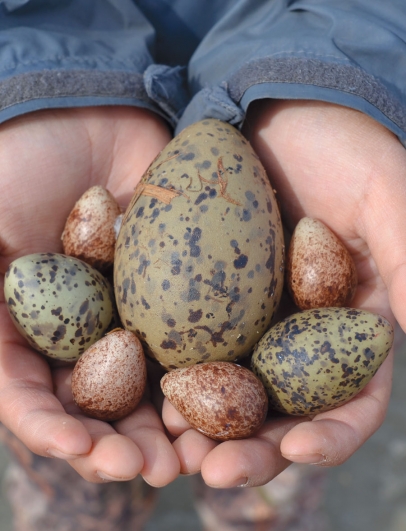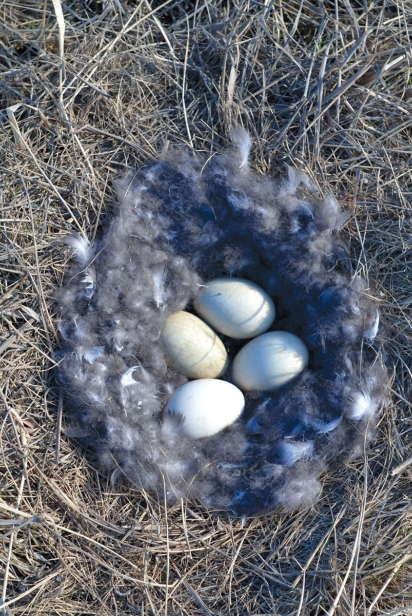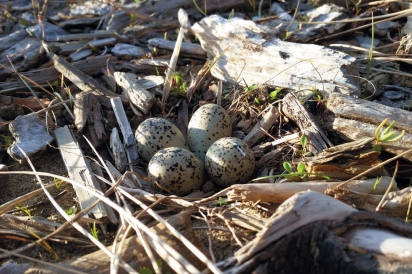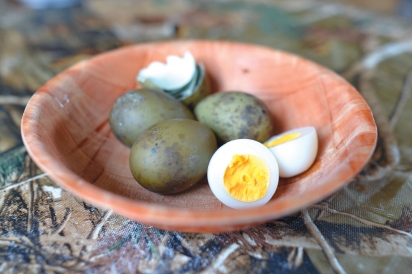Spring Traditions - Yukon Wild Bird Egg Harvest
Two skiffs head toward an expanse of mud and grass rising out of sapphire waters. The crisp ocean air buffets the smiling faces aboard. “This is my absolute favorite time of year,” exclaims Paniguaq, whose eyes sparkle in the sunlight. “It’s awesome to be out on the tundra with all the birds!” She has graciously invited me to join her extended family on a weekend camping trip in search of fresh flavors from the sea, land, and sky.
Paniguaq and her family live in one of the over forty Yup’ik villages located in the Yukon Delta National Wildlife Refuge. This refuge is in the ancestral homeland of the Yup’ik people and spans 19.5 million acres, roughly the size of the state of Maine. Seventy percent of the refuge consists of a dynamic web of wetlands, ponds, lakes, and rivers that drain the Yukon-Kuskokwim Delta before reaching the Bering Sea. In addition to a diversity of fish and marine mammals, the refuge contains the most important breeding and nesting grounds of eighty percent of black brant and nearly all emperor geese in North America. Hundreds of thousands of cackling Canada geese and Pacific greater white-fronted geese also make the refuge their summer residence.
Each year, millions of shorebirds, more than one million ducks, and around half a million geese gather here to nest and raise their young before staging epic migrations to places as far away as Russia, Mexico, Canada, and the rest of the United States.
Longer days and the return of birds signal the arrival of springtime in the delta. As soon as the snow melts in May or early June, the egging season begins. Eggs are the seeds of a new generation for the finned and feathered species of the north. They provide a nutrition packed catalyst for renewal and growth. In coastal villages, herring swim along the shore and lay eggs on seaweed-covered rocks. Some years, the beaches are encrusted with these translucent pale golden pearls. Families pluck herring egg-laden seaweed to munch fresh or put away for the winter. The tiny eggs have a texture that is rubbery and crunchy at the same time, with a briny flavor reminiscent of the Bering Sea.
Today, people actively harvest wild bird eggs in only a few places in the world, including Iceland, Canada, and Russia. In the United States, subsistence egg harvest is legal only in Alaska where it is a customary and traditional practice for Alaska Natives. Egging is possible because human communities in these remote areas coexist with unpolluted, pristine wilderness areas. By safeguarding these wilderness areas from major development and disturbance, people living in these extraordinary places — and local governments — ensure enough protected habitat for astonishingly large numbers of birds to breed and build their nests
Migratory birds in the Y-K Delta and the rest of Alaska are cooperatively managed by the Alaska Migratory Bird Co-Management Council (AMBCC), a unique partnership between federal and state agencies and Alaska Native organizations. Federal and state biologists work together with Alaska Native leaders to monitor populations and set regulations to protect threatened species. Community members and biologists are partners in maintaining healthy populations of birds shared by everyone.
Before Western foods came to Yup’ik communities, birds in the spring would sometimes be the lifeline against starvation, especially when winter foods ran out before summer foods became available. These days, wild foods are still vital for food security in a region off the road system. Store-bought foods are expensive, not as nutritious, and travel from thousands of miles away. The subsistence lifestyle also strengthens social connections within and between communities through sharing networks. Harvesting wild foods brings people in direct contact with the natural world and maintains the spiritual connection that links people with their ancestral homeland.
In the distance, moving dots speckle the sky. Egartagkaq and Nuyalran, our boat captains, steer us into a channel that cuts through the flats. Glimmering gray mud rises up on both sides of us as we meander through low-lying, grass-covered tundra. As we pass by, birds burst out of the grass like confetti. Their shrill voices fill the air as they dive and swoop, hover and fly away. We have arrived at the nesting grounds. “These are our traditions of where we live, and what we eat,” says Egartagkaq, as three generations of relatives tumble onto the tundra wearing rubber boots, buckets in hand. “This is who we are as Yup’ik people.”
Dried grass crunches beneath our feet as we tread on uneven ground. Keen eyes and practiced memories recognize camouflaged nests in the tundra and on the beach. The kids are the fastest of all the eggers. They gather around a clutch of eggs sitting in a pile of gray feathers interspersed with grass. An older Yup’ik man gently reminds the kids, “Make sure you leave a few eggs in the nest.” Two eggs are placed into their buckets, protected by a cushion of sphagnum moss at the bottom. Before continuing their quest, they carefully cover up the rest of the eggs in their downy blanket to protect them from predators until the parent birds return.
Both Yup’ik traditional teachings and Western science emphasize conservation practices to ensure the long-term sustainability of bird populations. “People in the communities are in tune with what the birds are doing,” said Bryan Daniels, a U.S. Fish and Wildlife Service waterfowl biologist for the Yukon Delta NWR. “They keep track of when they start laying and then collect eggs as early as possible.” Subsistence harvesting is open only a brief time after the snow melts. During peak nesting season, all egg and bird harvesting is closed to give birds time to hatch their eggs and raise their young in preparation for September migrations. For threatened species, egg harvesting is not permitted.
The variety of colors, shapes, and sizes of eggs is astoundingly diverse and as distinct as the different species of birds themselves. Many eggs, like seagull eggs, are freckled or patterned to blend in with the surroundings. Goose and duck eggs come in solid cream or sand colors. Eggs can be big or small, oval or conical. At camp, dinner is a Yup’ik feast on the beach: boiled spring plants, fresh herring caught in the morning, dried meat dipped in seal oil, and a colorful assortment of freshly boiled eggs. Most of the day’s egg harvest will be shared with elders and others back home in the village.
Apakuar is a gregarious Yup’ik woman who loves to be out on the tundra, gathering, preparing, and sharing these foods with her community. “Wild bird eggs have a distinct flavor,” she says. “They are much better than chicken eggs from the store.” Some yolks are such a deep orange color that scrambled wild eggs look as if they are infused with a generous helping of turmeric or paprika. Once in awhile, an egg will be harvested after having been incubated for several days. These yolks have a thick texture of custard and the whites will be runny when boiled. Most eggs are enjoyed boiled or fried. Any eggs not immediately used are frozen and saved for winter. When the frozen eggs are ready to be used, they go directly into a pot of boiling water and retain as much flavor as the day they were collected.
At this remarkable meeting place of water, land, and sky, spring subsistence activities bring people together to celebrate and savor the richness of the natural world. “When I eat these wild foods in the darkness of winter, it takes me back to the spring and summer when we work together as a family,” shares Apakuar. “I remember that feeling of freedom of being out in Mother Nature, out in Creation. It’s soul food.”









